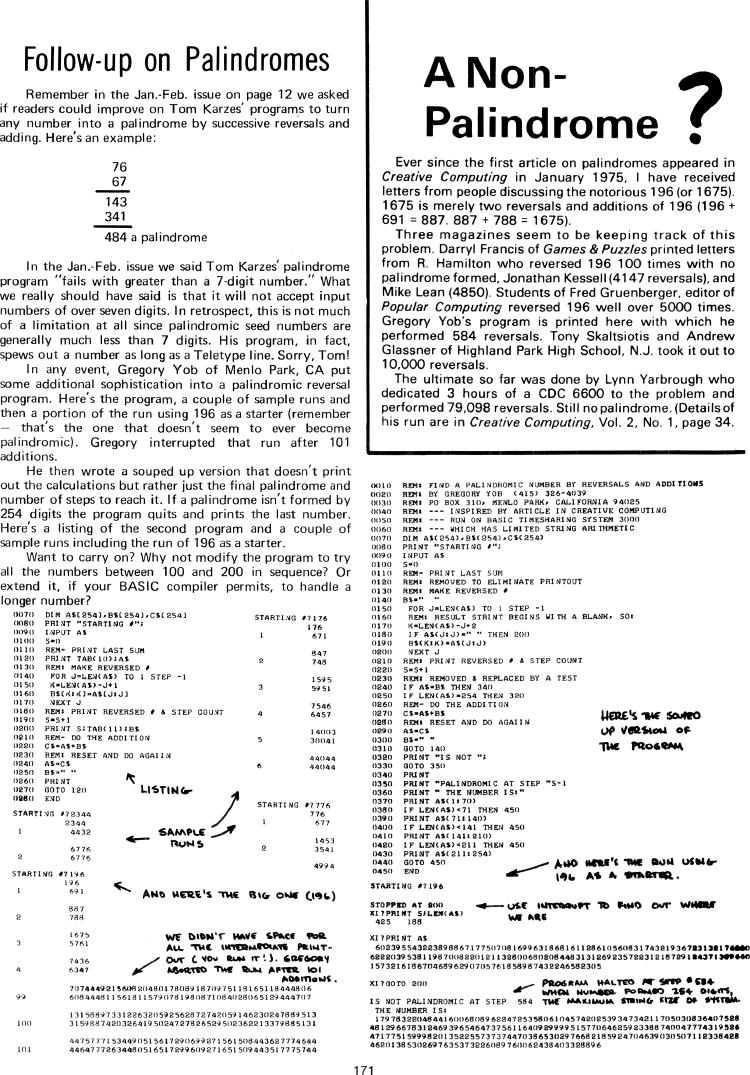The Best of Creative Computing Volume 1 (published 1976)
Palindromes: For Those Who Like to End at the Beginning (turning a number into a palindrome by successive reversals)

Follow-up on Palindromes
Remember in the Jan.-Feb. issue on page 12 we asked if readers could improve on
Tom Karzes' programs to turn any number into a palindrome by successive
reversals and adding. Here's an example:
76
67
---
143
341
---
484 a palindrome
In the Jan.-Feb. issue we said Tom Karzes' palindrome program "fails with
greater than a 7-digit number." What we really should have said is that it will
not accept input numbers of over seven digits. In retrospect, this is not much
of a limitation at all since palindromic seed numbers are generally much less
than 7 digits. His program, in fact, spews out a number as long as a Teletype
line. Sorry, Tom!
In any event, Gregory Yob of Menlo Park, CA put some additional sophistication
into a palindromic reversal program. Here's the program, a couple of sample runs
and then a portion of the run using 196 as a starter (remember - that's the one
that doesn't seem to ever become palindromic). Gregory interrupted that run
after 101 additions.
He then wrote a souped up version that doesn't print out the calculations but
rather just the final palindrome and number of steps to reach it. If a
palindrome isn't formed by 254 digits the program quits and prints the last
number. Here's a listing of the second program and a couple of sample runs
including the run of 196 as a starter.
Want to carry on? Why not modify the program to try all the numbers between 100
and 200 in sequence? Or extend it, if your BASIC compiler permits, to handle a
longer number?
***
0070 DIM A$[254],B$[254],C$[254]
0080 PRINT "STARTING #";
0090 INPUT A$
0100 S=0
0110 REM- PRINT LAST SUM
0120 PRINT TAB(10);AS
0130 REM: MAKE REVERSED #
0140 FOR J=LEN(A$) TO 1 STEP -1
0150 K=LEN(A$)-J 1
0160 B$[K:K]=A$[J:J]
0170 NEXT J
0180 REM: PRINT REVERSED # & STEP COUNT
0190 S=S 1
0200 PRINT S;TAB(11);B$
0210 REM- DO THE ADDITION
0220 C$=A$ B$
0230 REM: RESET AND DO AGAIN
0240 A$=C$
0250 B$=" "
0260 PRINT
0270 GOTO 120
0280 END
***
[image]LISTING
***
STARTING #?176
176
1 671
847
2 748
1595
3 5951
7546
4 6457
14003
5 30041
44044
6 44044
***
STARTING #?776
776
1 677
1453
2 3541
4994
***
STARTING #?2344
2344
1 4432
6776
2 6776
***
[image]SAMPLE RUNS[image]
***
[image]AND HERE'S THE BIG ONE (196)
[image]WE DIDN'T HAVE SPACE FOR ALL THE INTERMEDIATE PRINT-OUT (YOU RUN IT!).
GREGORY ABORTED THE RUN AFTER 101 ADDITIONS.
***
STARTING #?196
196
1 691
887
2 788
1675
3 5761
7436
4 6347
7074449215608204801780891870975115165118444806
99 6084448115618115790781980871084028065129444707
13158897331226320592562872742059146230247889513
100 31598874203264195024727826529502362213379885131
44757771534490515617290699271561508443627774644
101 44647772634480516517299609271651509443517775744
***
0010 REM: FIND A PALINDROMIC NUMBER BY REVERSALS AND ADDITIONS
0020 REM: BY FREGORY YOB (415) 326-4039
0030 REM: PO BOX 310, MENLO PARK, CALIFORNIA 94025
0040 REM: --- INSPIRED BY ARTICLE IN CREATIVE COMPUTING
0050 REM: --- RUN ON BASIC TIMESHARING SYSTEM 3000
0060 REM: --- WHICH HAS LIMITED STRING ARITHMETIC
0070 DIM A$[254],B$[254],C$[254]
0080 PRINT "STARTING #";
0090 INPUT A$
0100 S=0
0110 REM- PRINT LAST SUM
0120 REM: REMOVED TO ELIMINATE PRINTOUT
0130 REM: MAKE REVERSED #
0140 B$=" "
0150 FOR J=LEN(A$) TO 1 STEP -1
0160 REM: RESULT STRING BEGINS WITH A BLANK, SO:
0170 K=LEN(A$)-J 2
0180 IF A$(J:J)="" THEN 200
0190 B$[K:K]=A$[J:J]
0200 NEXT J
0210 REM: PRINT REVERSED # & STEP COUNT
0220 S=S 1
0230 REM: REMOVED & REPLACED BY A TEST
0240 IF A$=B$ THEN 340
0250 IF LEN(A$)=254 THEN 320
0260 REM- DO THE ADDITION
0270 C$=A$ B$
0280 REM: RESET AND DO AGAIN
0290 A$=C$
0300 B$=" "
0310 GOTO 140
0320 PRINT "IS NOT ";
0330 GOTO 350
0340 PRINT
0350 PRINT "PALINDROMIC AT STEP "S-1
0360 PRINT " THE NUMBER IS:"
0370 PRINT A$(1:70)
0380 IF LEN(A$)<71 THEN 450
0390 PRINT A$(71:140)
0400 IF LEN(A$)<141 THEN 450
0410 PRINT A$(141:210)
0420 IF LEN(A$)<211 THEN 450
0430 PRINT A$(211:254)
0440 GOTO 450
0450 END
***
HERE'S THE SOUPED UP VERSION OF THE PROGRAM
***
[image]AND HERE'S THE RUN USING 196 AS A STARTER.
***
[image]USER INTERRUPT TO FIND OUT WHERE WE ARE
***
[image]PROGRAM HALTED AT STEP # 584 WHEN NUMBER FORMED 254 DIGITS, THE MAXIMUM
STRING SIZE OF SYSTEM.
***
STARTING #?196
STOPPED AT 200
XI?PRINT S;LEN(A$)
425 188
XI?PRINT A$
60239554322389886717750708169963186816112861056083174321936723138176880
622203953811987008220121132600680205448313126923572231215729124371309660
15732161867046896290705761858987432246582305
XI? GOTO 200
IS NOT PALINDROMIC AT STEP 584
THE NUMBER IS:
179783220484416006808962247253580610457420253934734211705030836407528
4812966783124693965464737561164092999951577064625923388740047774319526
4717751599982013522557373744703865302976682185924704639030507112338428
46201385302697635373226089760062438403328896
***
A Non-Palindrome ?
Ever since the first article on palindromes appeared in Creative Computing in
January 1975, l have received letters from people discussing the notorious
196(or 1675). 1675 is merely two reversals and additions of 196 (196 691 =
887. 887 788 = 1675).
Three magazines seem to be keeping track of this problem. Darryl Francis of
Games & Puzzles printed letters from R. Hamilton who reversed 196 100 times with
no palindrome formed, Jonathan Kessell (4147 reversals), and Mike Lean (4850).
Students of Fred Gruenberger, editor of Popular Computing reversed 196 well over
5000 times. Gregory Yob's program is printed here with which he performed 584
reversals. Tony Skaltsiotis and Andrew Glassner of Highland Park High School,
N.J. took it out to 10,000 reversals.
The ultimate so far was done by Lynn Yarbrough who dedicated 3 hours of a CDC
6600 to the problem and performed 79,098 reversals. Still no palindrome.
(Details of his run are in Creative Computing, Vol. 2, No. 1, page 34.
***
171


